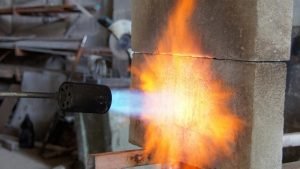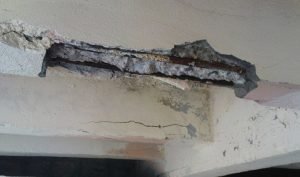Is steel stronger than concrete?
The most asked question was is steel stronger than concrete? The short answer is No. In some situations, the concrete is more batter than steel and also same case with steel. For detail answers please read the full article.
The compressive strength of concrete is more than the steel, to handle tension forces steel bars are used in the concrete because of the weakness of concrete. The wall made of concrete alone is much stronger than the mass of steel.

Concrete buildings have many safety advantages as compare to steel structure, concrete offers excellent protection from the explosion and endure very high temperatures for a long period of time. Concrete buildings are very fast and are attractive options.
As steel is also possible for large sections but using more time and meaningless time developing and the cost of insuring a steel building is higher than concrete because of differences in safety. Steel is now commonly used to keep protecting the environment and reinforcement.
When it comes to building design, steel offers a greater array of options. The strength of the weight of steel is higher than other construction materials.
Concrete is extremely strong in compression but when there is tension concrete has no strength, for this, the rebar is used in concrete to give it the ability to stand with tensile loads.
Reinforced concrete with steel is a good option for construction than concrete and steel separately. Concrete structures can take compressive stresses but cannot handle tensile stresses.
Concrete Vs Steel:

1: Strength:
Steel Structure:
The steel structure is strong, stiff, ductile and tough and making it one of the most leading material used in industrial and commercial building construction.
Concrete:
Concrete is a material that consists of sand, water, gravel, and cement. The concrete has higher compressive strength but the tensile strength is low. To increase the structure’s tensile capacity, elasticity, and ductility, concrete must be reinforced with steel.
2: Fire Resistance:
Steel Structure:
Steel is a non-combustible material and its strength can be significantly compromised when heated to extreme pressure. To improve safety steel requires to be covered with fire-resistance materials.
Concrete:
The concrete is naturally fire-resistant due to the composition of concrete. Many of the other components used in construction are not fire-resistant when concrete is used for building construction. To prevent complications within the overall structure professionals should know all the safety codes.

3: Sustainability:
Steel Structure:
As 90% of steel structure is created from recycled steel & steel structures are 100% recyclable. Steel can be used as adapted multiple times no compromise to its structural integrity due to its long lifespan. The steel structure will have minimum impact on the environment and is fabricated and treated properly when manufactured
Concrete:
Reducing the harm to our world concrete is natural to our environment; concrete may be crushed and used in other mixtures and this recycling reduces the presence of concrete in landfills.
4: Versatility
Steel Structure:
For endless applications steel is a flexible material and can be fabricated into a wide array of designs. Steel offers different aesthetic options that different materials and the strength to weight ratio is much higher as compared to other materials
Concrete:
Concrete can be molded into the many different shapes and when it comes to the floor to floor and log constructions heights it does some limitations.
5: Cost:
Steel Structure:
The price of steel can fluctuate and remains a less expensive option as compared to reinforced concrete. Today the steel comes from recycled materials and this recycling makes the material much cheaper.
Concrete:
Concrete requires ongoing maintenance and repairs throughout its lifetime and its price remains relatively consistent. The process to complete the concrete structure can be lengthy and higher labor costs.
6: Corrosion:
Steel Structure:
When it comes into contact with water steel may corrode and it could also affect safety and security of structure if left without proper care. Paint care and water-resistant are the processes of care. When water-resistant seals are applied fire-resistant features may be included.
Concrete:
Reinforced concrete is water-resistant and not corrodes with proper care and construction the important thing to note is that the steel reinforcement inside should never be exposed.
7: Design Possibilities:
Steel Structure:
Steel buildings remain a popular choice for office and multifamily developers in new construction methods. The use of staggered truss, girder slab, and castled beam construction enables the lower floor to floor height.
Steel can open bay footprints and accomplish long spans in structure without intermediate columns and it is also flexible material.
Concrete:
Everywhere the concrete buildings are taking many shapes and you can also shape anything from concrete. These buildings offer some real space advantages and with proper engineering concrete buildings also offer floor plates.
8: Environmental Consideration:
Steel Structure:
As 90% of the steel is recycled, the magnets are used to sort steel. Increasing the energy needed for transport steel fabrication made is done at a significant distance.
Concrete:
Concrete is often locally sourced and required minimal energy to transport to sites. From recycled steel rebar is produced for the concrete and concrete at the end of life can be crushed and recycled but recycled material cannot be used for the new buildings.
Difference B/w Structural Steel And Reinforced Concrete:
Advantages Of Concrete:
- Reinforced concrete proof quality and safety as compared to wood, steel, etc and also boasts of better fire.
- To shape with molding types it is flexible and moldable.
- Cost-effective. Lower labor cost.
- Requires less specification of steel.
- Low maintenance cost
Disadvantages Of Concrete:
- Concrete has low compressive strength and required mixing, curing and casting.
- It is an expensive option.
- Demands strict quality control.
- Salt deposits may form on the surface
Advantages Of Structural Steel:
- In terms of labor and materials, it is cost-effective.
- Useful for commercial and office buildings.
- Optimized space.
- Reasonable price.
- Easily available.
- Low self-weight.
- stiffness
Disadvantages Of Structural Steel:
- It requires special tools to use.
- Not many builders use this.
- Through fire damage, while concrete cannot be used structural steel components can be created. Requires high skilled labor.
- Low fire resistance.
Read Also:
We Love Cricket